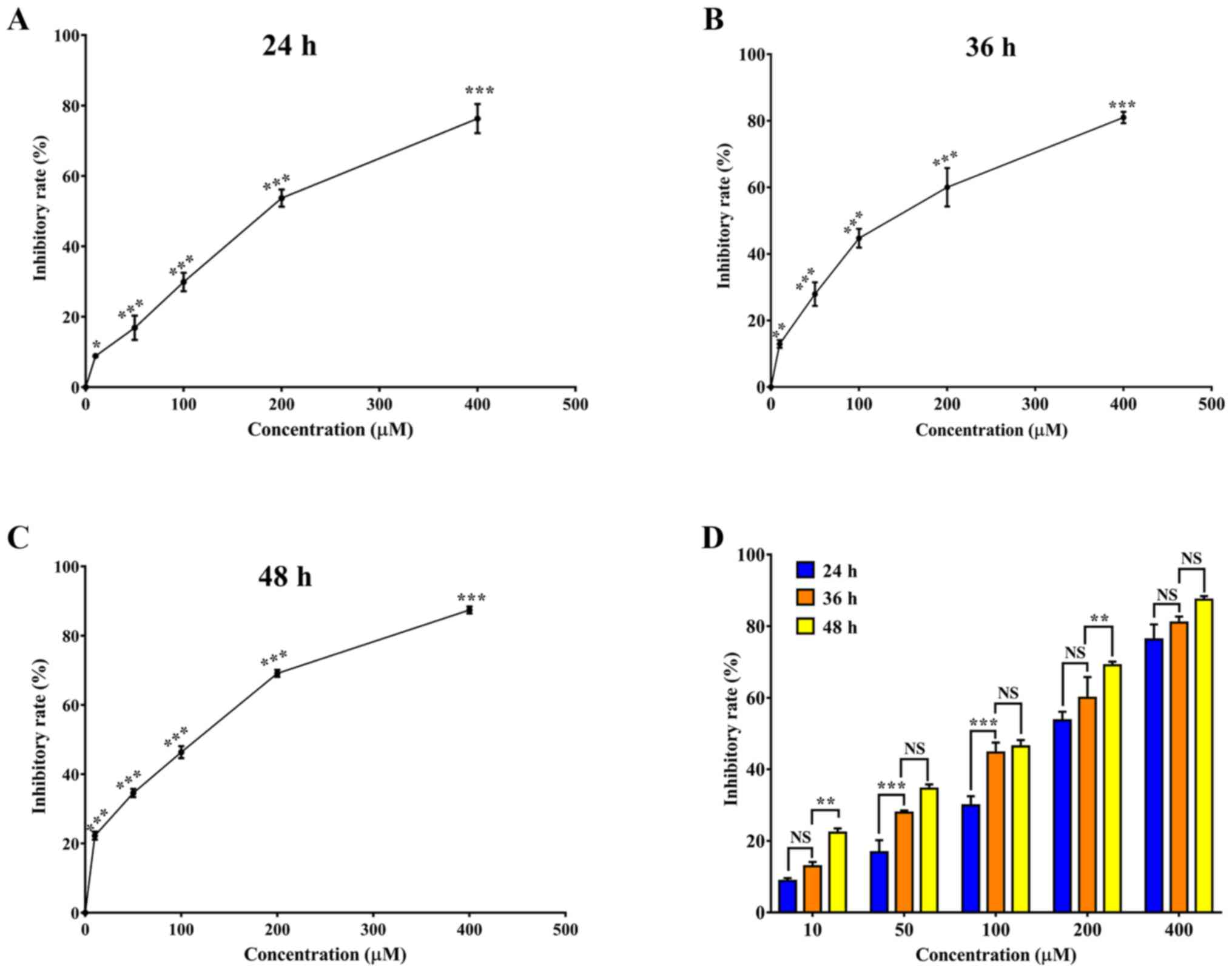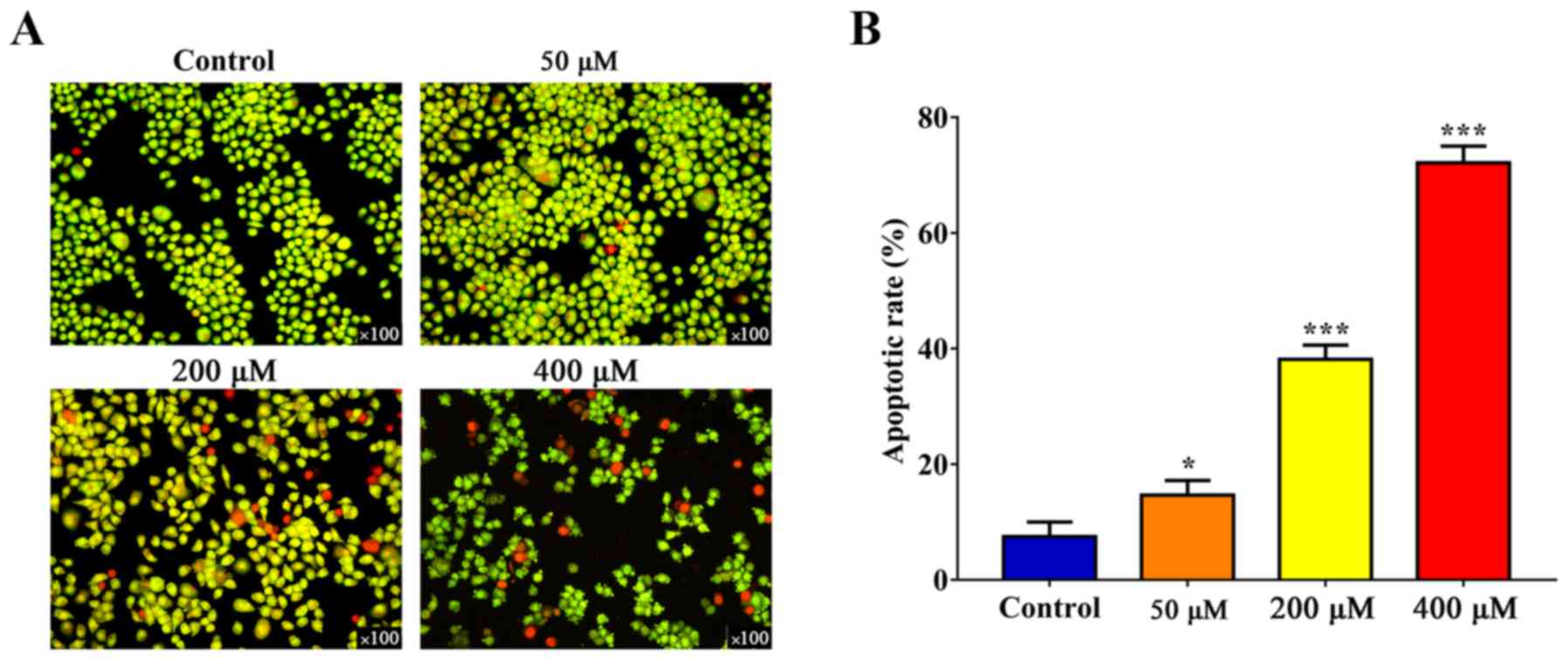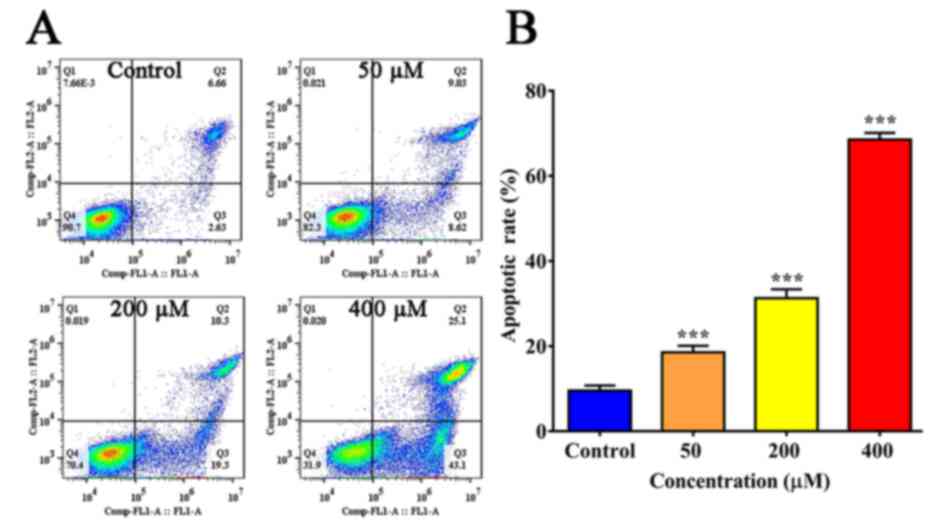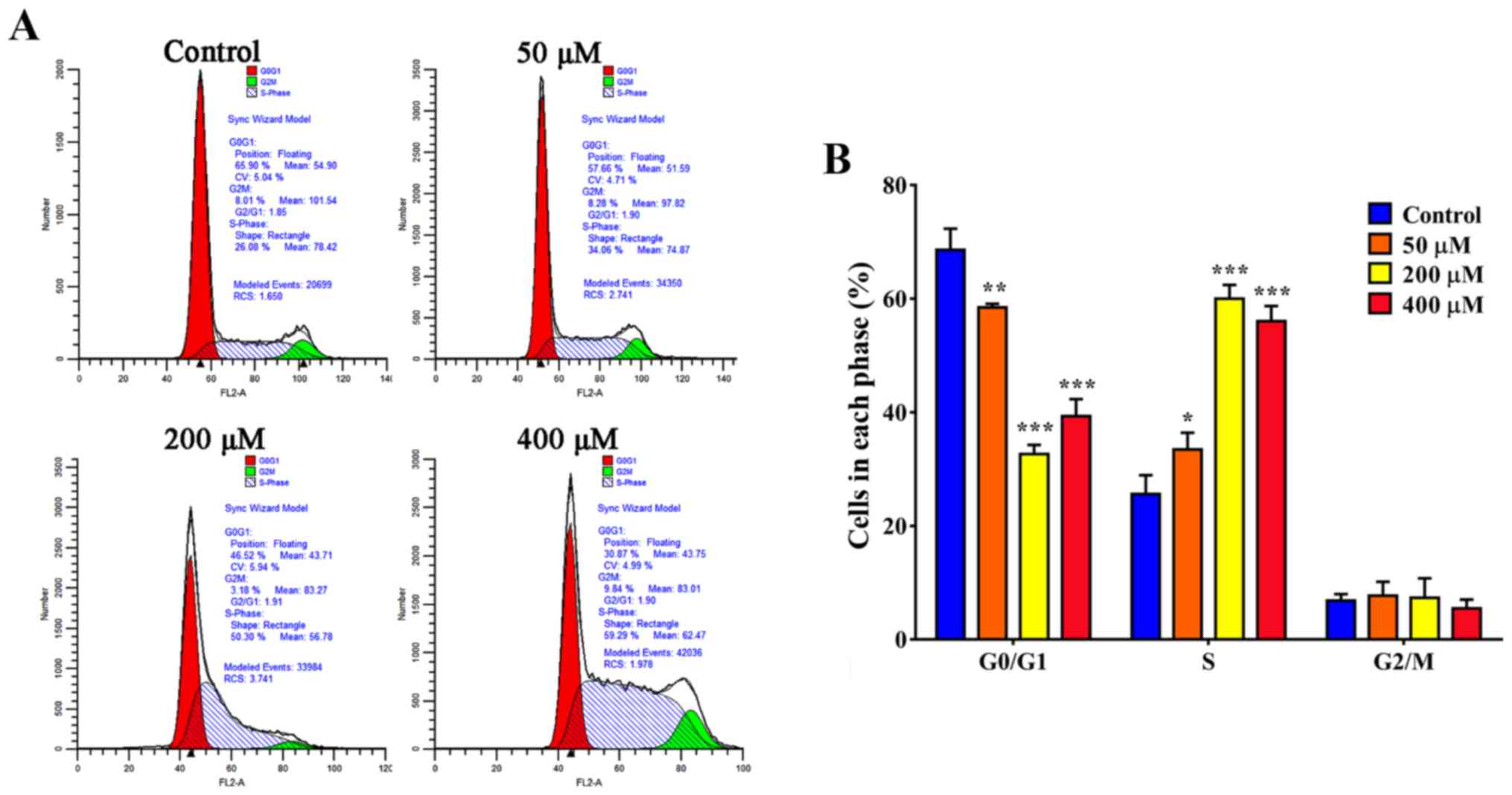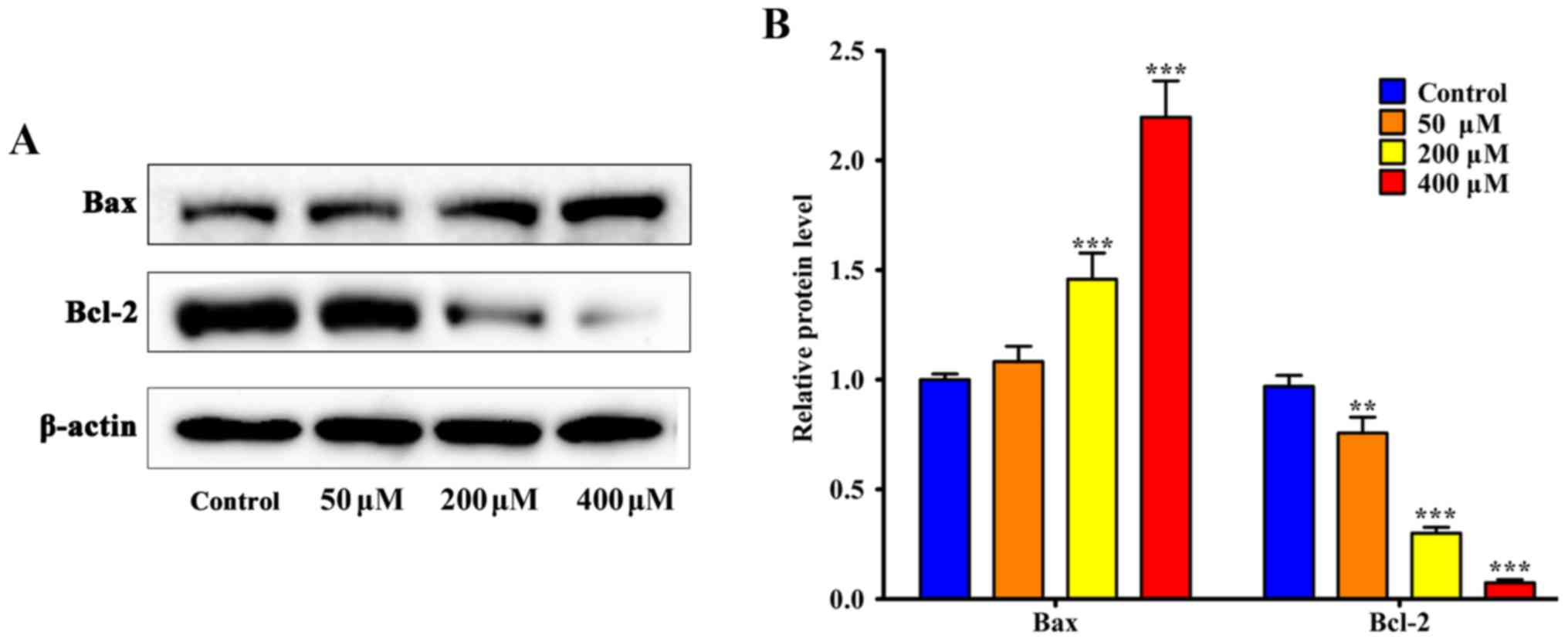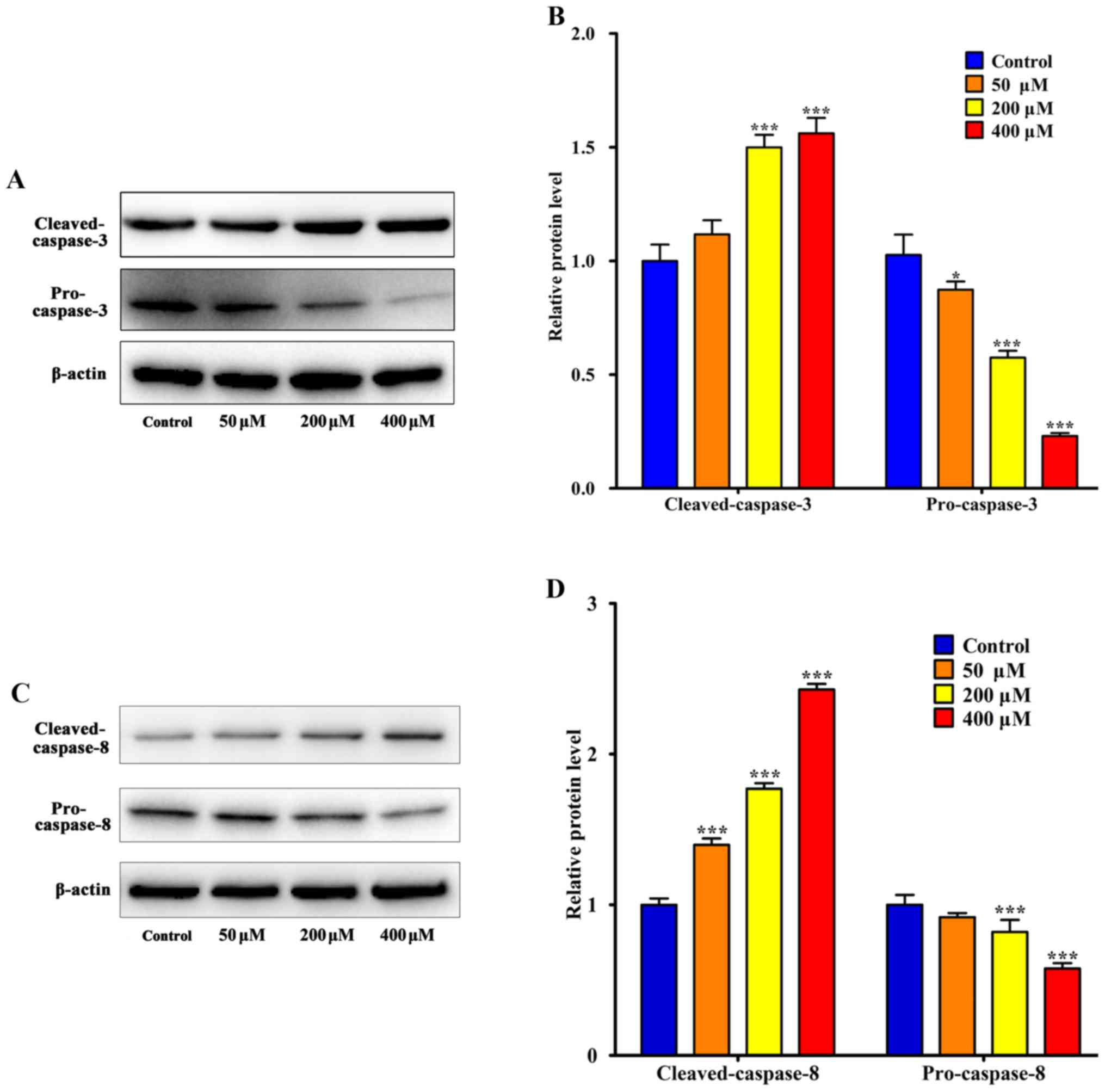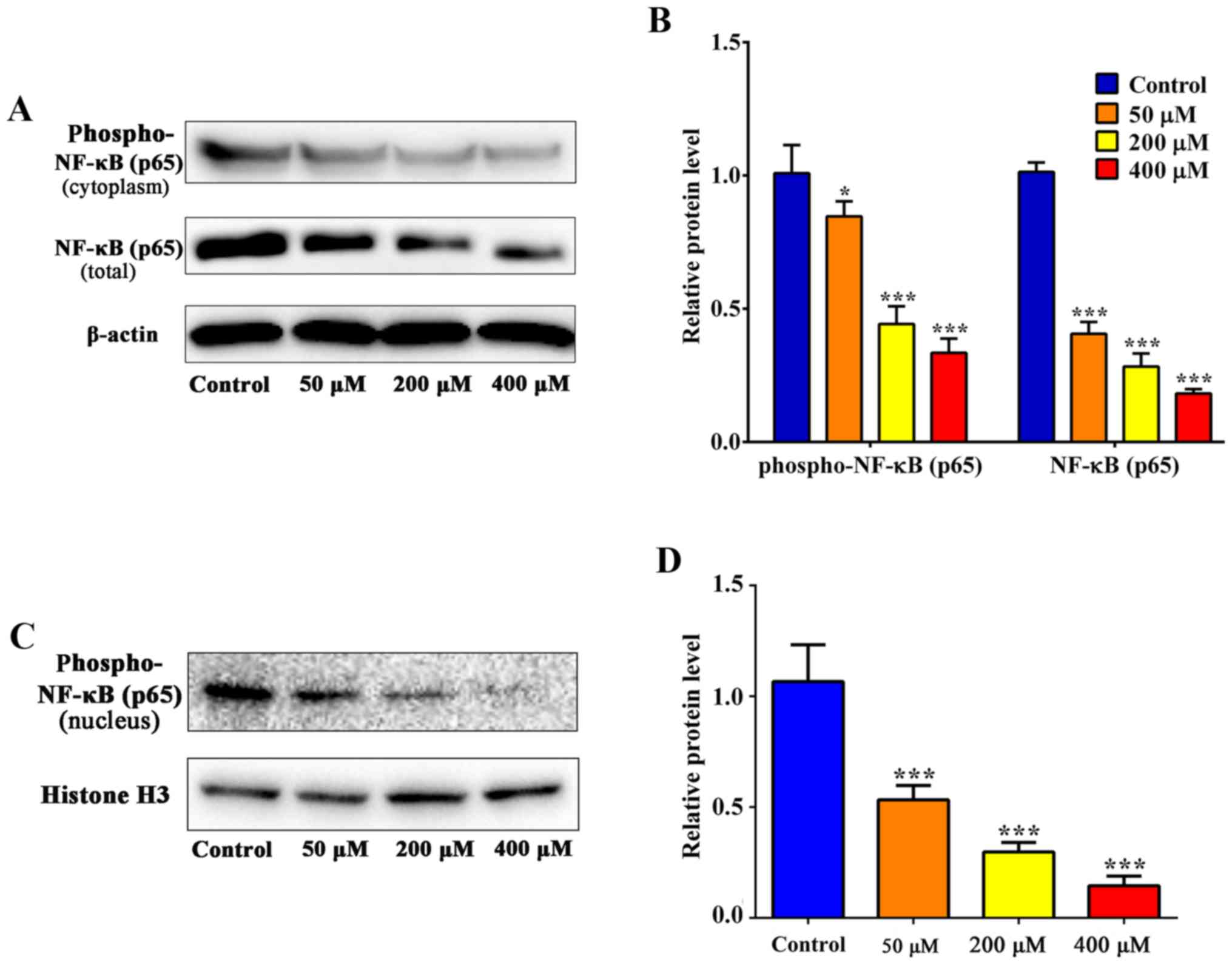Resveratrol induces apoptosis in SGC‑7901 gastric cancer cells
- Authors:
- Published online on: June 28, 2018 https://doi.org/10.3892/ol.2018.9045
- Pages: 2949-2956
-
Copyright: © Wu et al. This is an open access article distributed under the terms of Creative Commons Attribution License.
Abstract
Introduction
Gastric cancer is a common malignancy with high morbidity and mortality in men and women (1). The 5-year relative survival rate of patients with gastric cancer is only ~20% worldwide (2). In 2012, ~952,000 individuals were diagnosed with gastric cancer and ~723,000 succumbed to the disease (3). The conventional method of treating gastric cancer is surgery, and, when accompanied by adjuvant chemotherapy and radiotherapy, the prognosis of patients with gastric cancer may be markedly improved (4). Chemotherapy is a successful method of decreasing pain and prolonging the life expectancy of patients with gastric cancer (5). However, owing to side effects and drug resistance, the clinical efficacy of chemotherapeutic agents is limited (6,7). Owing to a small number of side effects and the wide range of targets of plant-derived components, a number of previous studies have focused on the function of plant-derived agents in antitumor treatment (8–10).
Resveratrol (3,4,5-trihydroxystilbene) is a natural phytoalexin product, and is widely present in a variety of plants, including grapes, berries and the Chinese medicine plant Polygonum cuspidatum (Japanese knotweed) (11). As an important component of red wine, resveratrol has long been hypothesized to exhibit cardioprotective effects, and it is well-known for its phytoestrogenic and antioxidant properties (12–15). In addition, previous studies have identified that resveratrol was able to prolong lifespan and resist cancer. For instance, feeding fish with resveratrol resulted in an increase in median and maximum lifespan by 33 and 27%, respectively, compared with fish that were fed without resveratrol supplementation (16). Furthermore, injection of resveratrol into mice led to a significant inhibition of the proliferation of breast cancer stem cell-like cells by suppressing the Wnt/β-catenin signaling pathway (17). Although these studies demonstrated the antitumor effect of resveratrol, the precise underlying molecular mechanisms remain unclear.
In the present study, the gastric cancer cell line SGC-7901 was used to investigate the effects and acting mechanisms of resveratrol on cell viability and apoptosis. The results may provide an improved understanding of the effects of resveratrol in the treatment of gastric cancer.
Materials and methods
Chemicals and reagents
Resveratrol (Chemical Abstracts Service identifier, 501-36-0; purity ≥99%), MTT, acridine orange (AO), ethidium bromide (EB) and propidium iodide (PI) were purchased from Sigma-Aldrich; Merck KGaA (Darmstadt, Germany). Resveratrol was dissolved in dimethyl sulfoxide (DMSO) to form a 100 mM stock solution. MTT was dissolved in PBS to form a 5 mg/ml working solution. RPMI-1640 medium was purchased from HyClone; GE Healthcare (Chicago, IL, USA) and fetal bovine serum (FBS) was purchased from Hangzhou Sijiqing Biological Engineering Materials Co., Ltd. (Hangzhou, China). All other chemicals and reagents used in the present study were of analytical grade.
Cell culture
SGC-7901 cells were purchased from the China Center for Type Culture Collection (Wuhan, China) and cultured in RPMI-1640 medium supplemented with 10% FBS and antibiotics (100 U/ml streptomycin and 100 U/ml penicillin) in 25-cm2 culture flasks at 37°C in a humidified atmosphere containing 5% CO2. When the SGC-7901 cells reached exponential growth phase, the cells were subcultured and the experiments were performed on the subcultured cells.
MTT assay
The anti-proliferative effect of resveratrol against SGC-7901 cells was determined using the colorimetric MTT assay as described previously (18). The SGC-7901 cells were seeded on 96-well culture plates with RPMI-1640 medium at a density of 1×104 cells/ml. Following incubation for 24 h at 37°C, the cells were treated with different concentrations of resveratrol (0, 10, 50, 100, 200 and 400 µM) for 24, 36 and 48 h. Subsequently, 10 µl MTT (5 mg/ml) was separately added to each well, and the cells were cultured at 37°C for an additional 3 h. Finally, 150 µl DMSO was separately added to each well and the optical density (OD) was determined at 490 nm using a microplate reader (Bio-Rad Laboratories, Inc., Hercules, CA, USA). The inhibition rate of resveratrol against the SGC-7901 cells was determined using the equation: Inhibition rate (%)=(ODcontrol-ODtreatment)/ODcontrol ×100.
AO/EB dual staining assay
The apoptosis of SGC-7901 cells induced by resveratrol was examined using an AO/EB dual-fluorescence staining assay as described previously (19). Sterile round coverslips were placed on the bottom of the wells of a 12-well plate onto which the SGC-7901 cells were seeded with RPMI-1640 medium at a density of 1×104 cells/ml. After 24 h of incubation at 37°C, the cells were treated with different concentrations of resveratrol (0, 50, 200 and 400 µM) for 24 h. Subsequently, the round coverslips were removed. Dual-fluorescence staining solution (10 µl) containing 100 µg/ml AO and 100 µg/ml EB was added to each suspension prior to being covered with a coverslip. The morphology of cells was examined in each sample within 20 min using a fluorescence microscope (Nikon 80i; Nikon Corporation, Tokyo, Japan).
Apoptosis assay
Cell apoptosis was determined using flow cytometry following treatment as described previously (20). SGC-7901 cells were seeded in 6-well culture plates with RPMI-1640 medium and left to attach overnight at 37°C at a density of 1×104 cells/ml. Following treatment with resveratrol (0, 50, 200 and 400 µM) for 24 h, the cells were harvested and prepared as cell suspensions. Adherent cells were digested with EDTA-free trypsin and washed three times with ice-cold PBS. Subsequently, the cells (1×106 cells/ml) were resuspended in 200 µl staining buffer. Annexin V-fluorescein isothiocyanate staining solution (2 µl) was then added to the cell suspension. The mixture was gently mixed and incubated in the dark at 2–8°C for 15 min. Subsequently, 4 µl PI staining solution was added to the cell suspension. The mixture was mixed and incubated in the dark at 2–8°C for 5 min. The apoptotic cells were quantified immediately using a flow cytometer (BD Accuri C6; BD Biosciences, Franklin Lakes, NJ, USA) and the results were analyzed using FlowJo software (version 7.6; FlowJo LLC, Ashland, OR, USA).
Cell cycle assay
Cell cycle distribution was detected using a flow cytometer following drug treatment as described previously (21). SGC-7901 cells were seeded in 6-well culture plates at a density of 1×104 cells/ml with RPMI-1640 medium and left to attach overnight at 37°C. Following treatment with resveratrol (0, 50, 200 and 400 µM), cells were incubated further with the compounds for 24 h at 37°C before being harvested, washed twice with PBS and resuspended in 2 ml ice-cold PBS. The cells were fixed with cold (−20°C) 70% ethanol overnight at 4°C. Following three PBS washes, the cells were resuspended in 2 ml PI/RNase staining solution and incubated for 1 h at 4°C. Cells were quantified immediately using a flow cytometer (BD Accuri C6) and the results were analyzed using ModFitLT™ software (version 5.1; Verity Software House, Inc., Topsham, ME, USA). The PI fluorescence signal at FL2-A peak versus counts was used to determine cell cycle distribution.
Western blot analysis
Following treatment, proteins in SGC-7901 cells were extracted as described previously (22). Following treatment with resveratrol (0, 50, 200 and 400 µM) for 24 h, total protein was extracted with cell lysis buffer (Beyotime Institute of Biotechnology, Haimen, China), centrifuged at 13,4000 × g for 10 min at 4°C. Nuclear and cytosolic proteins were extracted using a Nuclear and Cytoplasmic Protein Extraction kit (Applygen Technologies, Inc., Beijing, China), according to the manufacturer's protocol. The cell lysate was mixed with 2 mM Na3VO4, as a phosphorylation protective agent. Protein concentrations were determined using a Bicinchoninic Acid Protein Assay kit (Wuhan Boster Biological Technology, Ltd., Wuhan, China), according to the manufacturer's protocol. Total protein (40 µg) was separated using SDS-PAGE (12% gel) and transferred onto a nitrocellulose membrane (EMD Millipore, Billerica, MA, USA). Following blocking with Tris-buffered saline containing 1% Tween-20 (TBST) and 5% fat-free milk powder, the membrane was incubated with primary antibodies against β-actin (cat. no. bs-0061R, 1:1,000; BIOSS, Beijing, China), histone H3 (cat. no. bs-0349R, 1:1,000; BIOSS), B-cell lymphoma 2 (Bcl-2; cat. no. bs-20351R, 1:200; BIOSS), Bcl-2-associated X protein (Bax; cat. no. bs-0127R, 1:200; BIOSS), cleaved caspase-3 (cat. no. BA2885-2, 1:200; Wuhan Boster Biological Technology, Ltd.), cleaved caspase-8 (cat. no. BA3971, 1:200; Wuhan Boster Biological Technology, Ltd.), pro-caspase-3 (cat. no. BM3954, 1:200; Wuhan Boster Biological Technology, Ltd.), pro-caspase-8 (cat. no. BM4423, 1:200; Wuhan Boster Biological Technology, Ltd.), nuclear factor κB (NF-κB) (p65) (cat. no. 10745-1-AP, 1:1,000; ProteinTech Group, Inc., Chicago, IL, USA) and phospho-NF-κB (p65) (cat. no. bs-0982R, 1:1,000; BIOSS) overnight at 4°C. The membrane was then washed with TBST and incubated with the corresponding horseradish peroxidase-conjugated goat anti-rabbit secondary antibody (Santa Cruz Biotechnology, Inc., Dallas, TX, USA) in TBST for 2 h at room temperature. Following a further rinse, all proteins were detected using chemiluminescence reagent (ECL Plus reagent; Beyotime Institute of Biotechnology). The result was analyzed using Image Lab™ software (version 5.0; MCM DESIGN, Hillerød, Denmark). β-actin was used as a loading control for whole cell and cytoplasmic proteins. Histone H3 was used as an internal control for detection of nuclear proteins.
Statistical analysis
Each experiment was performed at least three times. Results are presented as the mean ± standard deviation. The results were analyzed by one-way analysis of variance followed by a least significant difference post hoc test using SPSS (version 19.0; IBM Corp., Armonk, NY, USA). P<0.05 was considered to indicate a statistically significant difference.
Results
Resveratrol inhibits the viability of SGC-7901 cells
SGC-7901 cells were treated with different concentrations of resveratrol for 24, 36 and 48 h, respectively (Fig. 1A-C). Cell viability was analyzed by MTT assay. As presented in Fig. 1D, the inhibition of cell viability was significantly increased in SGC-7901 cells in response to resveratrol in a dose- and time-dependent manner compared with the control group (0 µM resveratrol) (P<0.05).
Resveratrol induces the apoptosis of SGC-7901 cells
SGC-7901 cells were treated with different doses of resveratrol for 24 h, labeled using AO/EB and examined using a fluorescence microscope (Fig. 2A). The staining of early-stage apoptotic cells was marked by crescent-shaped or granular yellow-green AO nuclear staining, and orange nuclear EB staining was asymmetrically localized in late-stage apoptotic cells. In the control group, no obvious apoptotic changes were identified by flow cytometric analysis. However, the number of apoptotic cells was significantly increased following resveratrol treatment in a dose-dependent manner (Figs. 2B and 3).
Resveratrol promotes S-phase arrest in SGC-7901 cells
Cell cycle distribution was observed by flow cytometric analysis. As presented in Fig. 4A, the proportion of cells in S-phase increased to 34.06% in the presence of resveratrol (50 µM) compared with 26.08% in the control group (P<0.05). When treated with 200 µM resveratrol, the proportion of SGC-7901 cells in S-phase was 59.29%; however, the proportion of SGC-7901 cells in S-phase was 50.3% when treated with 400 µM resveratrol (Fig. 4).
Effect of resveratrol on NF-κB expression
The apoptosis-associated proteins Bax and Bcl-2, caspase-3 and caspase-8 were detected using western blotting. The results indicated that 200 µM resveratrol induced significant upregulation of Bax and cleaved caspase-3 compared with the control group, respectively (P<0.001; Figs. 5 and 6). Additionally, Bcl-2 was significantly downregulated following treatment with 50 µM resveratrol (P<0.01; Fig, 5). As presented in Fig. 6, SGC-7901 cells that were treated with 50 µM resveratrol exhibited an increase in the expression of activated cleaved caspases compared with the control group. In addition, resveratrol treatment decreased the levels of pro-caspase-3 and pro-caspase-8. Following resveratrol treatment, the activation of caspase-3 and caspase-8 increased. These results suggested that resveratrol-induced cell death is associated with the death receptor pathway. In addition, western blot analysis was used to determine the levels of NF-κB (p65) and phospho-NF-κB (p65) (Fig. 7A). The level of NF-κB (p65) expression was significantly decreased following treatment with 50 µM resveratrol compared with the control (P<0.001; Fig. 7B), which suggests that the inhibition of the NF-κB signaling pathway was involved in resveratrol-induced apoptosis in SGC-7901 cells. As presented in Fig. 7B and D, phospho-NF-κB (p65) expression decreased in the cytoplasm and in the nucleus.
Discussion
The results of the present study indicated that resveratrol was able to significantly inhibit the viability and induce the apoptosis of SGC-7901 cells in a dose- and time-dependent manner within a certain range, which is consistent with the results of a previous study on pancreatic cancer (23).
By analyzing the results of the MTT assay, it was identified that when the concentration of resveratrol was ≥50 µM (except 200 µM), the inhibition rates of cell viability at 36 h were not significantly different from those at 48 h at the same concentration. Additionally, when the concentration of resveratrol was ≥200 µM, the inhibition rates of cell viability were not significantly different between 24 and 36 h at the same concentration. We hypothesize that, once the concentration had increased to a certain point, prolonging the duration of drug treatment did not make a difference to the inhibition of cell viability following resveratrol treatment.
Decreased cell viability is a comprehensive response, which reflects the functional state of cells in a number of aspects. Inhibition of cell proliferation, induction of apoptosis or autophagy, and cytotoxic necrosis all decrease cell viability. Yu et al (24) demonstrated that resveratrol decreases cell viability by way of the induction of apoptosis and G2/M-phase cell cycle arrest. However, Opipari et al (25) identified that resveratrol induces cell death in ovarian cancer A2780 cells via a mechanism distinct from apoptosis. Neither apoptotic pathways associated with Bcl-2 and Bcl-xL nor activation of caspase-9 were demonstrated to be required for the resveratrol-induced death of A2780 cells. Furthermore, decreased cell viability associated with the induction of autophagy was observed in breast cancer stem-like cells following treatment with resveratrol (17).
The cell cycle is a basic process common to all living organisms. The cell cycle can be divided into two major phases: Mitosis phase (M-phase) and interphase. On the basis of DNA synthesis, interphase is divided into G1-, S- and G2-phases. It has been identified that the effect of resveratrol on the cell cycle is primarily via two mechanisms: i) Decreasing the proportion of G0/G1-phase cells; and ii) blocking S-phase cells, namely the G1-S and S-G2 transitions, thereby inhibiting tumor cell proliferation (26). In the present study, cell cycle assay indicated that resveratrol was able to arrest SGC-7901 cells at S-phase, suggesting that blocking S-phase cells may be associated with resveratrol-induced apoptosis in SGC-7901 cells.
Apoptosis, an efficient cell death program, is primarily mediated via the intrinsic or the extrinsic pathway in response to different stimuli in various cell types. Dysregulated apoptosis is a distinguishing feature of human cancer. The initiation and execution of endogenous and exogenous apoptosis are regulated by Bcl-2 and caspase family proteins (27,28). It is well-known that Bcl-2 is an anti-apoptotic protein, and Bax is a pro-apoptotic protein (29). The balance of these two types of protein has a key function in regulating the sensitivity of cells to apoptosis (30). In the present study, the results indicated that the Bax/Bcl-2 ratio increased with resveratrol treatment, which suggested that resveratrol may inhibit the proliferation of gastric cancer cells via downregulating anti-apoptotic proteins and upregulating pro-apoptotic proteins. Abnormal caspase expression and activation have been involved in various types of cancer (31,32). In the present study, western blot analysis indicated that the levels of cleaved caspase-3 protein in SGC-7901 cells significantly increased following resveratrol treatment. By contrast, expression of pro-caspase-3 and pro-caspase-8 was markedly decreased in the experimental groups following resveratrol treatment. Furthermore, this resulted in a higher ratio of cleaved caspase-3/pro-caspase-3 (8). Therefore, increased caspase-3 and caspase-8 activation in the presence of resveratrol may contribute to resveratrol-induced apoptosis of SGC-7901 cells.
The NF-κB family of transcription factors is known for its function in immunity and inflammation (33), and its abnormal upregulation has been observed in a number of types of cancer (34–37). In the present study, the expression of NF-κB was negatively associated with the viability and survival of SGC-7901 cells. The presence of an NF-κB-binding site in the Bcl-2 promoter has been identified. Transactivation of transcription by NF-κB from the Bcl-2 p2 promoter is mediated via the Bcl-2 p2 site 1 (38). In certain cancer cell lines, the activation of NF-κB is triggered by chemotherapeutic drugs and ionizing radiation that accompany the activation of the Bcl-2 family of proteins (39). Sun et al (40) identified that resveratrol treatment was able to arrest cells at G1- and S-phases. NF-κB was also downregulated, which resulted in decreased expression of anti-apoptotic proteins, including Bcl-2, Bcl-2-like protein 1 and X-linked inhibitor of apoptosis. In myeloma, caspase-3 activation and loss of mitochondrial transmembrane potential were observed to be associated with resveratrol-induced apoptosis (41). In line with these results, it is possible that NF-κB has a key function in resveratrol-induced apoptosis in SGC-7901 cells. In the present study, resveratrol was able to downregulate the expression and activation of NF-κB in cancer cells, which regulated the expression of apoptotic-associated proteins and also modulated cell cycle distribution.
In conclusion, the results of the present study indicated that resveratrol was able to inhibit the viability and induce the apoptosis of SGC-7901 cancer cells by inhibiting NF-κB activation. Therefore, a potential application of resveratrol may be as an anticancer drug for the treatment of gastric cancer.
Acknowledgements
The authors thank Dr Zhigang Wang and Dr Jianghuan Hua (School of Basic Medical Sciences, Hubei University of Chinese Medicine, Wuhan, China), for assisting in the editing of the manuscript before submission.
Funding
The present study was supported by the Nature Science Foundation of Hubei Province, China (grant nos. 2013CFB067 and 2013CFB068).
Availability of data and materials
All data generated or analyzed during this study are included in this published article.
Authors' contributions
QFY, GZ and XXW conceived and designed the study. XXW, QL, YDX and BRZ performed the experiments. XXW and GZ wrote the paper. GZ, QFY, XXW, YDX, BRZ and QL reviewed and edited the paper. All authors read and approved the paper.
Ethics approval and consent to participate
Not applicable.
Patient consent for publication
Not applicable.
Competing interests
The authors declare that they have no competing interests.
References
|
Kamangar F, Dores GM and Anderson WF: Patterns of cancer incidence, mortality, and prevalence across five continents: Defining priorities to reduce cancer disparities in different geographic regions of the world. J Clin Oncol. 24:2137–2150. 2006. View Article : Google Scholar : PubMed/NCBI | |
|
Cunningham SC, Kamangar F, Kim MP, Hammoud S, Haque R, Maitra A, Montgomery E, Heitmiller RE, Choti MA, Lillemoe KD, et al: Survival after gastric adenocarcinoma resection: Eighteen-year experience at a single institution. J Gastrointest Surg. 9:718–725. 2005. View Article : Google Scholar : PubMed/NCBI | |
|
Stewart B and Wild CP: World Cancer Report 2014. Health. 2017. | |
|
Orditura M, Galizia G, Sforza V, Gambardella V, Fabozzi A, Laterza MM, Andreozzi F, Ventriglia J, Savastano B, Mabilia A, et al: Treatment of gastric cancer. World J Gastroenterol. 20:1635–1649. 2014. View Article : Google Scholar : PubMed/NCBI | |
|
Nobili S, Lippi D, Witort E, Donnini M, Bausi L, Mini E and Capaccioli S: Natural compounds for cancer treatment and prevention. Pharmacol Res. 59:365–378. 2009. View Article : Google Scholar : PubMed/NCBI | |
|
Florea AM and Büsselberg D: Cisplatin as an anti-tumor drug: Cellular mechanisms of activity, drug resistance and induced side effects. Cancers (Basel). 3:1351–1371. 2011. View Article : Google Scholar : PubMed/NCBI | |
|
Wu Q, Yang Z, Nie Y, Shi Y and Fan D: Multi-drug resistance in cancer chemotherapeutics: Mechanisms and lab approaches. Cancer Lett. 347:159–166. 2014. View Article : Google Scholar : PubMed/NCBI | |
|
James MI, Iwuji C, Irving G, Karmokar A, Higgins JA, Griffin-Teal N, Thomas A, Greaves P, Cai H, Patel SR, et al: Curcumin inhibits cancer stem cell phenotypes in ex vivo models of colorectal liver metastases, and is clinically safe and tolerable in combination with FOLFOX chemotherapy. Cancer Lett. 364:135–141. 2015. View Article : Google Scholar : PubMed/NCBI | |
|
He B, Wei W, Liu J, Xu Y and Zhao G: Synergistic anticancer effect of curcumin and chemotherapy regimen FP in human gastric cancer MGC-803 cells. Oncol Lett. 14:3387–3394. 2017. View Article : Google Scholar : PubMed/NCBI | |
|
Tran KQ, Tin AS and Firestone GL: Artemisinin triggers a G1 cell cycle arrest of human Ishikawa endometrial cancer cells and inhibits Cyclin Dependent Kinase-4 promoter activity and expression by disrupting NF-kB transcriptional signaling. Anticancer Drugs. 25:270–281. 2014. View Article : Google Scholar : PubMed/NCBI | |
|
Novelle MG, Wahl D, Diéguez C, Bernier M and de Cabo R: Resveratrol supplementation: Where are we now and where should we go? Ageing Res Rev. 21:1–15. 2015. View Article : Google Scholar : PubMed/NCBI | |
|
Baur JA and Sinclair DA: Therapeutic potential of resveratrol: The in vivo evidence. Nat Rev Drug Discov. 5:493–506. 2006. View Article : Google Scholar : PubMed/NCBI | |
|
Du RH, Dai T, Cao WJ, Lu M, Ding JH and Hu G: Kir6.2-containing ATP-sensitive K(+) channel is required for cardioprotection of resveratrol in mice. Cardiovasc Diabetol. 13:352014. View Article : Google Scholar : PubMed/NCBI | |
|
Inglés M, Gambini J, Miguel MG, Bonet-Costa V, Abdelaziz KM, El Alami M, Viña J and Borrás C: PTEN mediates the antioxidant effect of resveratrol at nutritionally relevant concentrations. Biomed Res Int. 2014:5808522014. View Article : Google Scholar : PubMed/NCBI | |
|
Labinskyy N, Csiszar A, Veress G, Stef G, Pacher P, Oroszi G, Wu J and Ungvari Z: Vascular dysfunction in aging: Potential effects of resveratrol, an anti-inflammatory phytoestrogen. Curr Med Chem. 13:989–996. 2006. View Article : Google Scholar : PubMed/NCBI | |
|
Valenzano DR, Terzibasi E, Genade T, Cattaneo A, Domenici L and Cellerino A: Resveratrol prolongs lifespan and retards the onset of age-related markers in a short-lived vertebrate. Curr Biol. 16:296–300. 2006. View Article : Google Scholar : PubMed/NCBI | |
|
Fu Y, Chang H, Peng X, Bai Q, Yi L, Zhou Y, Zhu J and Mi M: Resveratrol inhibits breast cancer stem-like cells and induces autophagy via suppressing Wnt/β-catenin signaling pathway. PLoS One. 9:e1025352014. View Article : Google Scholar : PubMed/NCBI | |
|
Yuan SL, Wei YQ, Wang XJ, Xiao F, Li SF and Zhang J: Growth inhibition and apoptosis induction of tanshinone II-A on human hepatocellular carcinoma cells. World J Gastroenterol. 10:2024–2028. 2004. View Article : Google Scholar : PubMed/NCBI | |
|
Arora S, Jain J, Rajwade J and Paknikar K: Interactions of silver nanoparticles with primary mouse fibroblasts and liver cells. Toxicol Appl Pharmacol. 236:310–318. 2009. View Article : Google Scholar : PubMed/NCBI | |
|
Chen X, Zhao G, Wang F, Gao F, Luo H, Wang Y, Du Y, Chen X, Xue C, Dong Z and Song G: Upregulation of miR-513b inhibits cell proliferation, migration, and promotes apoptosis by targeting high mobility group-box 3 protein in gastric cancer. Tumor Biol. 35:11081–11089. 2014. View Article : Google Scholar | |
|
Guo H, Xu YM, Ye ZQ, Yu JH and Hu XY: Curcumin induces cell cycle arrest and apoptosis of prostate cancer cells by regulating the expression of IkappaBalpha, c-Jun and androgen receptor. Pharmazie. 68:431–434. 2013.PubMed/NCBI | |
|
Zhu P, Zhang J, Zhu J, Shi J, Zhu Q and Gao Y: MiR-429 induces gastric carcinoma cell apoptosis through Bcl-2. Cell Physiol Biochem. 37:1572–1580. 2015. View Article : Google Scholar : PubMed/NCBI | |
|
Ding XZ and Adrian TE: Resveratrol inhibits proliferation and induces apoptosis in human pancreatic cancer cells. Pancreas. 25:e71–e76. 2002. View Article : Google Scholar : PubMed/NCBI | |
|
Yu XD, Yang JL, Zhang WL and Liu DX: Resveratrol inhibits oral squamous cell carcinoma through induction of apoptosis and G2/M phase cell cycle arrest. Tumour Biol. 37:2871–2877. 2016. View Article : Google Scholar : PubMed/NCBI | |
|
Opipari AW Jr, Tan L, Boitano AE, Sorenson DR, Aurora A and Liu JR: Resveratrol-induced autophagocytosis in ovarian cancer cells. Cancer Res. 64:696–703. 2004. View Article : Google Scholar : PubMed/NCBI | |
|
Kim AL, Zhu Y, Zhu H, Han L, Kopelovich L, Bickers DR and Athar M: Resveratrol inhibits proliferation of human epidermoid carcinoma A431 cells by modulating MEK1 and AP-1 signalling pathways. Exp Dermatol. 15:538–546. 2006. View Article : Google Scholar : PubMed/NCBI | |
|
Danial NN and Korsmeyer SJ: Cell death: Critical control points. Cell. 116:205–219. 2004. View Article : Google Scholar : PubMed/NCBI | |
|
Galluzzi L, Vitale I, Abrams JM, Alnemri ES, Baehrecke EH, Blagosklonny MV, Dawson TM, Dawson VL, El-Deiry WS, Fulda S, et al: Molecular definitions of cell death subroutines: Recommendations of the nomenclature committee on cell death 2012. Cell Death Differ. 19:107–120. 2012. View Article : Google Scholar : PubMed/NCBI | |
|
Phillips TM, McBride WH and Pajonk F: The response of CD24(−/low/CD44+ breast cancer-initiating cells to radiation. J Natl Cancer Inst. 98:1777–1785. 2006. View Article : Google Scholar : PubMed/NCBI | |
|
Tsujimoto Y: Role of Bcl-2 family proteins in apoptosis: Apoptosomes or mitochondria? Genes to cells. 3:697–707. 1998. View Article : Google Scholar : PubMed/NCBI | |
|
Estrov Z, Thall PF, Talpaz M, Estey EH, Kantarjian HM, Andreeff M, Harris D, Van Q, Walterscheid M and Kornblau SM: Caspase 2 and caspase 3 protein levels as predictors of survival in acute myelogenous leukemia. Blood. 92:3090–3097. 1998.PubMed/NCBI | |
|
Hopkins-Donaldson S, Bodmer JL, Bourloud KB, Brognara CB, Tschopp J and Gross N: Loss of caspase-8 expression in highly malignant human neuroblastoma cells correlates with resistance to tumor necrosis factor-related apoptosis-inducing ligand-induced apoptosis. Cancer Res. 60:4315–4319. 2000.PubMed/NCBI | |
|
Karin M and Greten FR: NF-kappaB: Linking inflammation and immunity to cancer development and progression. Nat Rev Immunol. 5:749–759. 2005. View Article : Google Scholar : PubMed/NCBI | |
|
Gasparini C, Celeghini C, Monasta L and Zauli G: NF-κB pathways in hematological malignancies. Cell Mol Life Sc. 71:2083–2102. 2014. View Article : Google Scholar | |
|
Pacifico F and Leonardi A: NF-kappaB in solid tumors. Biochem Pharmacol. 72:1142–1152. 2006. View Article : Google Scholar : PubMed/NCBI | |
|
Karin M: Nuclear factor-kappaB in cancer development and progression. Nature. 441:431–436. 2006. View Article : Google Scholar : PubMed/NCBI | |
|
Liu B, Sun L, Liu Q, Gong C, Yao Y, Lv X, Lin L, Yao H, Su F, Li D, et al: A Cytoplasmic NF-κB interacting long noncoding RNA Blocks IκB Phosphorylation and suppresses breast cancer metastasis. Cancer Cell. 27:370–381. 2015. View Article : Google Scholar : PubMed/NCBI | |
|
Catz SD and Johnson JL: Transcriptional regulation of bcl-2 by nuclear factor kappa B and its significance in prostate cancer. Oncogene. 20:7342–7351. 2001. View Article : Google Scholar : PubMed/NCBI | |
|
Li F and Sethi G: Targeting transcription factor NF-kappaB to overcome chemoresistance and radioresistance in cancer therapy. Biochim Biophys Acta. 1805:167–180. 2010.PubMed/NCBI | |
|
Sun C, Hu Y, Liu X, Wu T, Wang Y, He W and Wei W: Resveratrol downregulates the constitutional activation of nuclear factor-kappaB in multiple myeloma cells, leading to suppression of proliferation and invasion, arrest of cell cycle, and induction of apoptosis. Cancer Genet Cytogenet. 165:9–19. 2006. View Article : Google Scholar : PubMed/NCBI | |
|
Shimizu T, Nakazato T, Xian MJ, Sagawa M, Ikeda Y and Kizaki M: Resveratrol induces apoptosis of human malignant B cells by activation of caspase-3 and p38 MAP kinase pathways. Biochem Pharmacol. 71:742–750. 2006. View Article : Google Scholar : PubMed/NCBI |



